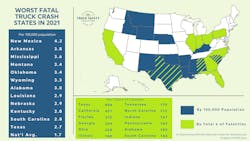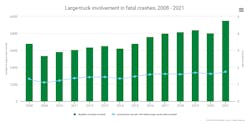United States roadways have been their deadliest in more than a decade in recent years. Portions of the Infrastructure Law address the safety of America's streets and highways, but one organization is calling on lawmakers to do more.
Last week, the Truck Safety Coalition and members of Congress called to advance truck safety reforms after the release of the TSC's "Deadliest Truck Crash States" report.
Ranking states as the deadliest for motorists involved in semi-truck collisions per 100,000 population, the report found several southern states to be the deadliest, including New Mexico, Arkansas, Mississippi, Oklahoma, Alabama, Louisiana, Kentucky, South Carolina, and Texas. Other states that made the top 12 list were Montana, Wyoming, and Nebraska. Findings were based on numbers from 2021—the most recent data available. The National Center for Statistics and Analysis at the National Highway Traffic Safety Administration generated the data for the report.In 2020, road travel decreased by 430.2 billion miles compared to 2019, per the Federal Highway Administration; however, the NHTSA found a 7.02% increase in fatalities from 2019 to 2020. This increase in roadway fatalities with a drastic decrease in miles traveled has been attributed to an increase in motorist speed, failure to wear a seat belt, and the involvement of alcohol or an illegal substance.
Things worsened in 2021 as these bad driving behaviors persisted and more motorists took to the roadways. A total of 42,939 U.S. roadway fatalities occurred—the highest number since 2005, the NHTSA reported.
Accidents that involved trucks were also included in these statistics, and they accounted for 9% of all vehicles involved in fatal crashes in 2021, the National Safety Council reported. Trucks involved in accidents resulting in injuries rose 12% in 2021 from 2020. Further, there were 5,700 large trucks involved in fatal crashes in 2021, an 18% increase from 2020, and these accidents resulted in the loss of 5,788 total lives.
Truck crash deaths have increased by 71% over the last decade, according to a release from the TSC, and the Council and members of Congress want that trend to begin to decrease.
See also: NFL QB's estate settlement after highway fatality shows trucking's lawsuit burden
"Truck crash deaths have continued to rise over the last 10 years, demonstrating the need for safety reforms," said Eleanor Holmes Norton, Washington, D.C.'s Congressional delegate and ranking member of the U.S. House Highways and Transit Subcommittee. "Safety was my first priority when working on the Infrastructure Investment and Jobs Act, including mandating automatic emergency braking, stronger standards for rear underride guards, and increased funding for safety programs, among other provisions. We can and must do more to reverse the rise in truck-related injuries and fatalities."
Current safety improvements through the Infrastructure Law
The Infrastructure Law has proposed requirements and laws to make roads safer, vehicles safer, improve safety research and data collection, and encourage safer driving behaviors.
The law invests $1 billion for local planning and projects to reduce roadway fatalities and crashes through the Safe Streets and Roads for All program. The law requires state and metropolitan planning organizations to adhere to and fund activities that support the Complete Streets policies and standards, which are developing streets that "ensure the safe and adequate accommodation of all users of the transportation system."
The legislation requires road managers to install and maintain traffic control devices, such as traffic lights, traffic signs, and lane markings. The law provides $3 billion to the Highway Safety Improvement Program that provides funding to state transportation departments to reduce traffic fatalities and serious injuries. Another $60 million will go toward decreasing the amount of wildlife-involved traffic collisions.
See also: FMCSA removes exact number from speed limiter proposal
To improve driving behaviors, new highway safety program eligibilities aim to improve the use of child restraints, reduce collisions with emergency response vehicles, improve vehicle recall awareness, eliminate child heatstroke, and increase drivers' education on new vehicle technologies. New advertising campaigns aim to promote the use of seat belts and decrease impaired driving.
The law aims to improve trucking safety through $471 million in funding for "high-visibility traffic enforcement efforts in high-crash corridors" to improve the safety of motor carriers and other motorists operating around large trucks. That funding will also help support investigations of unsafe trucking companies and $5 million of that will go toward commercial motor vehicle training and support.
To help make vehicles safer, the law requires all new passenger motor vehicles to be equipped with lane-departure and lane-keeping assist systems, forward collision warning and automatic emergency braking systems. The National Highway Traffic Safety Administration must also update its five-star crash-worthiness testing program, and changes should incorporate the latest technological advances. The law also requires the removal of vehicles deemed unsafe or those that fail inspection.
See also: What the largest infrastructure spending bill in history means for trucking
As for commercial trucks, the law requires that the Secretary establish performance requirements and safety standards for the use of automatic emergency braking systems as well as strengthen rear underride guard standards. The Department must also conduct additional research on rear and side impact guards to establish performance standards.
Additional Infrastructure Law funding will go toward data, research, and innovation to help inform future safety efforts and improve current safety activities.
Improvements the Truck Safety Coalition wants to see
Aside from the funding and the requirements, and improvements set forth by the Infrastructure Law, the Truck Safety Coalition is urging Congress and the U.S. Department of Transportation (DOT) to establish additional solutions—or enforce its requirements—to reduce truck crashes. These include:
- DOT/NHTSA must expeditiously finalize its Automatic Emergency Braking rule for all classes of CMVs.
- DOT/FMCSA must expeditiously complete its speed limiter rule for CMVs.
- Congress must require DOT/NHTSA to conduct side underride guard impact testing; not doing so fails to comply with Congressional intent in the Infrastructure Investment and Jobs Act.
- Congress must fully fund DOT to conduct its work without unsafe riders that prohibit FMCSA from implementing specific safety provisions for teen truckers in the Safe Driver Apprenticeship Program
- DOT/FMCSA must expeditiously require new motor carriers to pass a knowledge exam proving that they know and can implement Federal Motor Carrier Safety Regulations (FMCSRs) required to safely operate a motor carrier business, including those hauling hazardous materials. Currently, DOT allows anyone to operate in interstate commerce who files appropriate paperwork without requiring any evidence they know the rules to keep truck drivers and all roadway users safe.
As disturbing as the numbers were from 2020 and 2021, 2022 saw improvement, according to preliminary data from NHTSA, with a slight 0.3% decrease in roadway fatalities and a downward trend per quarter. This is also with a 0.9% increase in miles traveled. Early data from the first half of 2023 shows a continued decline in roadway fatalities, with a 3.3% decrease compared to the first half of 2022, according to the NHTSA.






